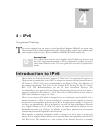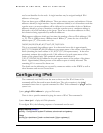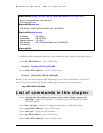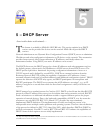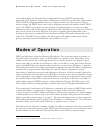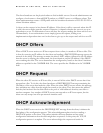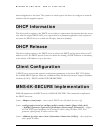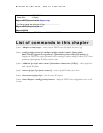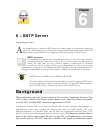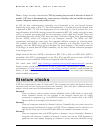
MAGNUM 6K SWITCHES, MNS-6K USER GUIDE
78
As described earlier, the Dynamic Host Configuration Protocol (DHCP) automates the
assignment of IP addresses, subnet masks, default gateway, DNS servers and other IP parameters.
When a DHCP configured machine boots up or regains connectivity after a power outage or
network outage, the DHCP client sends a query requesting necessary information from a DHCP
server. The DHCP server listens for such requests and responds back to the client providing
information such as the default gateway, the domain name, the DNS servers, other servers such as
time servers, extent of the lease and more. The query is typically initiated immediately after
booting up and must be completed before the client can initiate IP-based communication with
other hosts. The DHCP server replies to the client with an IP address, subnet mask, default
gateway, and other requested information such as DNS server, etc.
Modes of Operation
DHCP provides three modes for allocating IP addresses. The best-known mode is dynamic, in
which the client is provided a "lease" on an IP address for a period of time. Depending on the
stability of the network, this could range from hours (a wireless network at an airport or guest
access in an office) to months (for desktops in a lab or in an office). At any time before the lease
expires, the DHCP client can request renewal of the lease on the current IP address. A properly-
functioning client will use the renewal mechanism to maintain the same IP address throughout its
connection to a single network. Maintaining the same IP address is important to correct
functioning of higher-layer protocols and applications. However, if the lease actually expires, the
client must initiate a new negotiation of an IP address from the server's pool of addresses. As part
of the negotiation, it can request its expired IP address, but there are no guarantees that it will get
the same IP address. Many ISP’s today provide internet connectivity to the home over DSL or
cable modems using the DHCP protocol to better utilize the IP space. The DSL router or the
cable modem follows the same principles to allocate and reuse the IP address described above.
The second mode for allocation of IP addresses is automatic (also known as DHCP Reservation),
in which the address is “permanently” assigned to a client. In this mode an IP address is
“reserved” based on the MAC address of the device. When the lease expires, the same IP address
is allocated back to the client as long as the MAC address matches. This guarantees the same IP
address even after a power outage or a reboot
5
. The network administrators need to change the
MAC address should they want to reallocate the IP address to a different device. This reservation
method is widely used to allocate IP addresses to a specific zone or a subnet.
The third mode for allocation is manual, in which the address is selected at the client (manually by
the user or by some other means) and the DHCP protocol messages are used to inform the server
that the address has been allocated. The manual mode is rarely used as it requires human
5
This is true as long as the DHCP server is accessible and responds to the query





